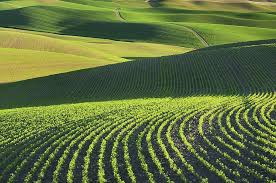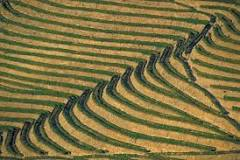AP Environmental Science Unit 5
1/62
Earn XP
Name | Mastery | Learn | Test | Matching | Spaced |
|---|
No study sessions yet.
63 Terms
Tragedy of the Commons
An act with self-interest which overexploits and depletes shared resources
Externalities
Negative costs associated with human actions, that aren’t accounted for in the price
Effects of clear cutting
Increases soil erosion, evaporation of water in soil, nitrates in streams, and amount of soil in the atmosphere. Impacts biodiversity more than selective cutting
Negative effects of tree plantations
Lowers biodiversity and all the same age
General forest benefits
Filtering of air pollutants, removal and storage of CO2 from the atmosphere, habitat for organisms
Deforestation consequences
Reduces air filtering and releases CO2
Slash and burn
Method of clearing land for agriculture by cutting trees and burning them
Furrow irrigation
Trench dug along crops and filled with water, 66% efficient
Drip irrigation
Holes is hose allow water to slowly drip out, 95% effective
Flood irrigation
Flooding entire field, 10% efficient
Spray irrigation
Surface water sprayed through pipes, 90% efficient
Soil salinization
The process of salt building up in soil over time
What does the depletion of aquifers cause
Saltwater intrusion, cone of depression
Green Revolution
A shift in agriculture away from small family operated farms to large industrial scale agribusiness
Monocropping
Growing one single species of crop
Tiling
Mixing and breaking up of soil to make planting easier
Pesticides
Chemicals that are toxic to pests, can cause pests to become resistant
GMOs in crops
Grow for pest resistant trait that is added through genetic modification
CAFO
Concentrated animal feeding operation
Manure lagoons
Large, open storage pits for animal waste
Overgrazing
Too many animals grazing an area of land removes all vegetation
Fishery
Populations of fish for commercial fishing
Fishery collapse
Collapse when overfishing causes 90% population die off, population may never recover
Bottom trawling
Dragging a large net along ocean floor, catches unintended targets and destroys reefs
Ore
Commercially valuable deposits of concentrated minerals that can be harvested and used as raw materials
Metals
Elements that have reduced electricity, heat, and have structural proportions for building
Reserve
The known amount of a resource left that can be mined
Overburden
Soil, vegetation, and rocks that are removed to get to a deposit below
Tailings and slag
Leftover waste material separated from the valuable metal of ore
Surface mining
Mining closer to the surface of the earth, open pit, becoming more scarce
Subsurface mining
More expensive due to higher insurance and health care for workers
Urbanization
The population shift from rural to urban areas, the corresponding decrease in the proportion of people living in rural areas, and the ways in which societies adapt to this change.
Natural storm water drainage
Stormwater infiltrates into the ground. Plants and tree work to absorb stormwater
Urban stormwater drainage
Water hits impervious surface and urns off roofs, streets, parking lots, etc. Runoff goes into the sewers
Urbanization in coastal cities
The process of developing coastal areas for human use. May result in water pollution, habitat loss, and extreme weather
Trends in population
The world is growing more slowly, aging, and becoming more urbanized
Urban sprawl
Uncontrolled expansion of cities into surrounding areas
Solutions to urban sprawl
Public transit, walkable communities, zoning policies
Ecological footprint
The impact of a person or community on the environment, expressed as the amount of land required to sustain their natural resources
Carbon footprint
Measured by how much carbon emissions a person produces
What is the average US ecological footprint?
5.1 Earths
What is the current global footprint?
1.85 Earths
Sustainability
The ability to meet the needs of the present without compromising on the present
Maximum sustainable yield
The maximum amount of a renewable resource that can be harvested without reducing or depleting the resource for future use
Biodiversity
The variety of life on Earth, all living organisms and ecosystems
Environmental consequences of urban runoff
Runoff can carry pollutants like oil, pesticides, fertilizer, and bacteria into waterways
Permeable pavement
Specifically designed to allow stormwater to infiltrate groundwater, more costly than traditional pavement
Rain gardens
Gardens planted in urban areas around a storm drain, decreases runoff
Public transit
More cars on the road = more pollutants on streets, public transit decreases runoff
Building Up, Not Out
Building vertically decreases impervious surfaces, can be combined with green roof or rooftop gradens
Integrated Pest Management
Using a variety of pest control methods that minimize the environmental disruption and pesticide use
Biocontrol
Introducing a natural predator, parasite, or competitor to control the pest population
Crop rotation (IPM)
Rotating crops can prevent pests from becoming established
Soil conservation
Agricultural techniques that minimize erosion
Contour plowing
Plowing parallel to the natural slopes

Terracing
Creating flat platforms, or terraces, on a mountainside

Perennial crops
Crops that live year round
Windbreaks
Using trees or other plants to break wind
No till
Adding leftover crop remains to soil
Strip cropping
Form of intercropping, using alternating rows of different crops
Green manure
Leftover plant material after a growing season
Limestone in soil
Releases calcium carbonate (base) which neutralizes the soil
Prescribed burning
A controlled burn in a forest area